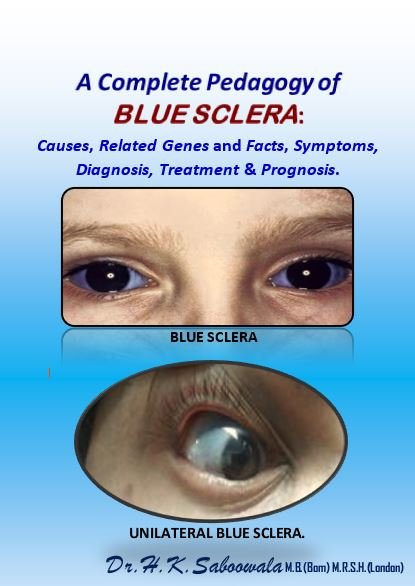For Medical Professionals, Researchers, and Curious Learners.
Introduction:
Blue Sclera Diagnosis is an essential clinical clue in identifying several genetic and connective tissue disorders. The eyes often reflect deeper systemic clues—and one such visual signal is blue sclera. This bluish tint of the white part of the eye is more than a cosmetic curiosity—it can serve as a clinical indicator of genetic disorders, collagen defects, or systemic diseases.
This blog, unpacks the pedagogical spectrum of blue sclera: from its underlying causes and related genes to symptoms, diagnostic significance, treatment, and even rare clinical presentations such as unilateral blue sclera.
What Is Blue Sclera?
Blue sclera occurs when the white of the eye appears bluish due to the translucency of the thin scleral collagen, allowing the underlying uveal pigment to show through. It’s not a disease itself, but a clinical sign of various disorders.
Genetic Causes in Blue Sclera Diagnosis and Related Genes
- Blue sclera can be seen in a range of genetic syndromes, including:
- Osteogenesis Imperfecta (COL1A1, COL1A2 mutations)
- Ehlers–Danlos Syndrome
- Marfan Syndrome
- Iron-deficiency anemia and silver deposition disorders (non-genetic)
- Understanding the underlying genetic pathway can guide clinicians toward early diagnosis of connective tissue disorders.
Clinical Symptoms & Diagnostic Evaluation are well described in the book
Symptoms That Support Blue Sclera Diagnosis.
- Thin Cornea
- Epicanthal fold
- Myopia,
A Rare Insight: Unilateral Blue Sclera
It is strived present a unique illustrated case of unilateral blue sclera, emphasizing the importance of side-specific presentation in differential diagnosis.
Treatment and Prognosis
While blue sclera itself may not require treatment, but addressing the underlying cause is necessary.
- Nutritional therapy (iron, calcium, vitamin C)
- Fracture prevention strategies
- Systemic monitoring
Conclusion:
Blue sclera is more than a visual anomaly—it is a clinical clue. Recognizing and investigating it can lead to early diagnosis of complex syndromes, better patient management, and improved outcomes.
This comprehensive, informative eBook offers deep insights into the causes, genes, symptoms, diagnosis, and prognosis of blue sclera, presented with multiple illustrations and real-world case discussions.
“Mastering Blue Sclera Diagnosis enhances early detection of genetic syndromes.”
Prognosis.
Depends on the primary disorder. In conditions like osteogenesis imperfecta, multidisciplinary care greatly improves outcomes.
About the eBook:
This e-Booklet by Dr. H. K. Saboowala, provides:
- A concise but complete clinical pedagogy
- Extensive illustrations
- Diagnostic algorithms
- Case-based insights
It’s tailored for medicos aiming to connect ocular signs to systemic understanding.
Download Now:

Cover Page of “Complete Clinical Pedagogy of Blue Sclera.”
Explore the full illustrated eBook by visiting
Home
🧠 Rare Case in Blue Sclera Diagnosis: Unilateral Blue Sclera
… (your paragraph ends here)
Related Reading: Microbial Tales from the Crypt – Space Bacteria
Related Reading: Base Editing: A Precise Genetic Breakthrough in Modern Medicine
OR Scan the “QR code” below to access over 350+ high-value medical titles.

Medical Review:
“This is a timely reminder that subtle signs like blue sclera may uncover systemic and genetic conditions. A valuable resource for clinicians.”
Dr. S. Dhanraj, MD (Clinical Genetics & Paediatrics)
Thank You Note
With appreciation,
Dr. H. K. Saboowala.M.B. (Bom), M.R.S.H. (London) F..F.M.(UK)


